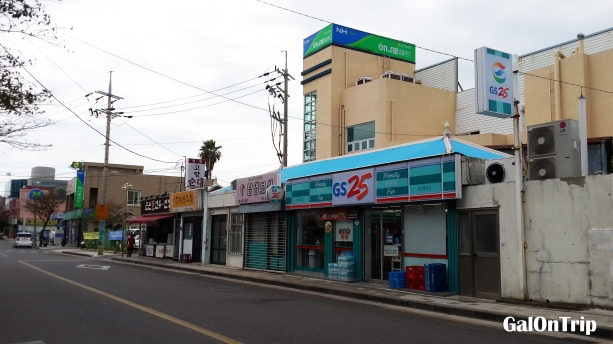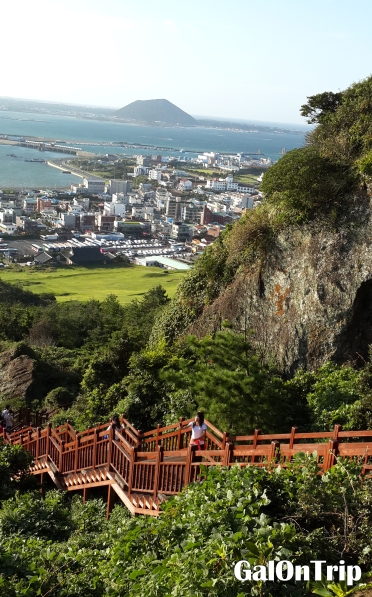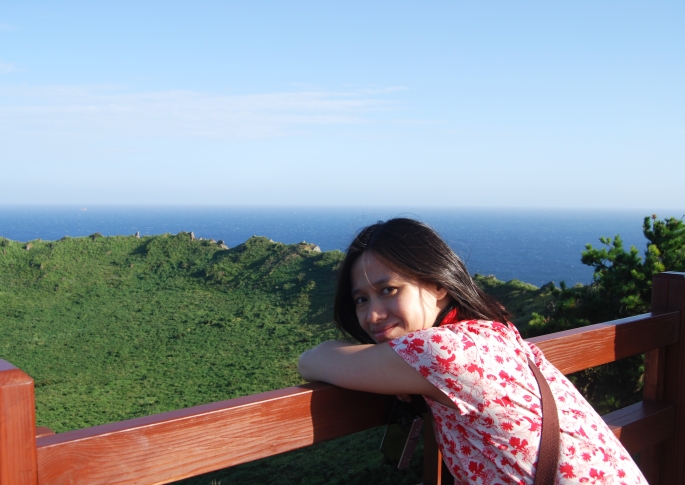When we arrived in Jeju City, we just realized that all the main attractions shown beautifully on Google Images are not simply around the corner. Although Jeju City is the capital city of Jeju Island, the truth is that many of them are situated about an hour or more from the city.
Final Verdict: Public Bus
We prioritized on visiting something unique and typical from Korea’s Island of Gods, Seongeup Folk Village and one of The 7 Wonders of Nature, Seongsan Sunrise Peak (Seongsan Ilchulbong), where both are situated in the east side of Jeju Island. We actually would like to see all the East attractions as seen in Yeha Tour brochure below, but we woke up too late. Blame it on soju hangover the day before.
Instead of taking the bus tour that costs KRW 79,000 ($ 68.97) per person (as in 2013 rate), we decided to do it by public bus for the sake of adventure and budget saving. The closest intercity bus stop was merely 3 minutes walking distance from You & I Guesthouse.

Mingle, Be Patient and Be Observant
It was a blazing afternoon and burning sunshine when we mingled with crowds who don’t or hardly speak English at the station. Except a young Caucasian man in late 20’s with earphones attached in both of his ears, whose body language showed some kind of certainty of what he had to do, depicting familiarity of his surrounding in the place he’s not originally come from.
I noticed a completely different atmosphere compared to Seoul. Not only they are more fashion laid back and do not rush that much, but also the significant amount of elderly women (aka widows?) on street. Even more than retired couples. K-Pop and K-Dramas apparently do not give the whole picture of certain parts of Korea. Gen Y and Gen Z people in the island have less exposure of plastic surgery that make them look real, instead of homogenized beauty referring to current trend.

When the bus arrived, I hurriedly pointed the location map of Seongeup Folk Village to the driver to make sure we were in the right bus. He nodded. Phew! Then, we inserted KRW 2000 ($ 1.74) each in the fare box in front of us.
It required a bit more patience, though, to wait for everyone to be on board. Especially elderly women who took more time to climb up the bus from the pavement. Sometimes, the driver gave some hands to them voluntarily. Later on, I realized that it happened several times in a day.
I was impressed by the cleanliness and appropriateness inside the bus. The corduroy fabrics covering the seats looked like brand new. The handle bars, the ceiling, the windows, the floor were definitely in perfect condition. From this point of view, I didn’t see much difference from the tourist bus.
Within 20 minutes, the Caucasian man left the bus. And there we were, the only non-Korean speakers left inside. We really counted on the woman whom we could only hear the voice, presenting bilingual information with the same opening line. Firstly in Korean, secondly in English, saying “Next station is…..”, followed by mentioning the nearest places of interest.
The appearance of buildings were replaced by green fields and rows of trees in clear sky as the bus went further, leaving the city. The countryside view was look alike along the way after an hour journey. Most tourist attractions were not immediately visible after the bus stopped at the station where they are located, except a huge signboard situated a few hundred meters prior to the arrival.
Therefore, hearing sense was the most important of all to ensure we got off at the right station. When in doubt, ask the driver.
Better Visited when Guided

We finally succeeded arriving in Seongeup Folk Village by walking further for 200 meters from the bus stop. The entrance was free, but it is best visited when guided because we kept making lucky guesses to understand what’s really going on in that village.
There were local officials explaining and demonstrating the ancient way of preparing food and storing agriculture products and so on, but too bad it was all conducted in Korean. They hardly understood any English either. However, we were happy enough to see the distinctive look of the traditional houses.


Stranded
Our journey to Seongsan Ilchulbong was not as smooth as before. There were several bus stops nearby the folk village that confused us. Furthermore, communicating with the locals were not that easy because of the language barrier. We ended up taking the wrong bus and the driver advised us to get off somewhere in the small town we don’t know what it’s called to change another bus heading to our desired destination.

There were a very few inhabitants on street, including a mom taking her daughter to a grocery store and a group of elderly women hanging out with fellas. It was a relief to witness a sign of life in a very quiet neighborhood while waiting for the next bus a little longer.
Up, Up, Up to the Cone
After a 10 minute-walk from the station, passing through seafood, barbecue restaurants, local and international cafe and restaurant chains, such as Lotteria, Angel in Us and Starbucks, eventually a big tuff cone known for its legendary crater stood gracefully before us. That was Seongsan Ilchulbong.
The temperature changed dramatically, about 10 degrees Celsius colder than that in Jeju City, and the wind blew strong. My bad, I just wore a t-shirt dress without any jacket. A very wrong kind of outfit of the day.

A final round to accomplish before heading back to the guesthouse: climbing up the stairs for 180 meters high and immortalize the moment when we reached the top: the crater with 600 meters diameter and 90 meters high.


Unlike Seongeup Folk Village, Seongsan Ilchulbong is much more prepared to welcome foreign tourists with explanations in English and Korean engraved on marble stone in each stop on the way up. It came to my surprise that crater looks more like a soccer field with grasses covering the surface.

Time flew, and it was about half an hour before closing time. Before reaching the exit, accidentally we spotted the location of Woman Diver Show, another place of interest mentioned in Yeha brochure. But we didn’t go there because show had ended.

We followed the crowds walking to the same direction, the bus station. The return trip to Jeju City was so much easier without the need for transfers. It gave us more time to rest since the journey took about 2.5 hours.

With a little help from Mr. Nice Guy, who informed us about the public bus, a conventional map and some guts, we were proud of ourselves that we made it without guided tour, Google Map and arrived in Jeju City safely in the evening.
In a nutshell, the infrastructure in Jeju Island is user friendly for tourists. The availability of public buses help a lot of people to travel on budget without neglecting comfort and safety. I really recommend visitors to try this, to leave the comfort zone, enjoy the unexpected journey, exploring the Island of Gods on your own!
Spoiler: I will give some tips and estimated budget of our Jeju trip in my next post. Stay tuned!


Its interesting and elaborate story. Good inside story although I am not sure if I can follow your steps. Thanks for sharing the experience
LikeLike
You’re welcome
LikeLike